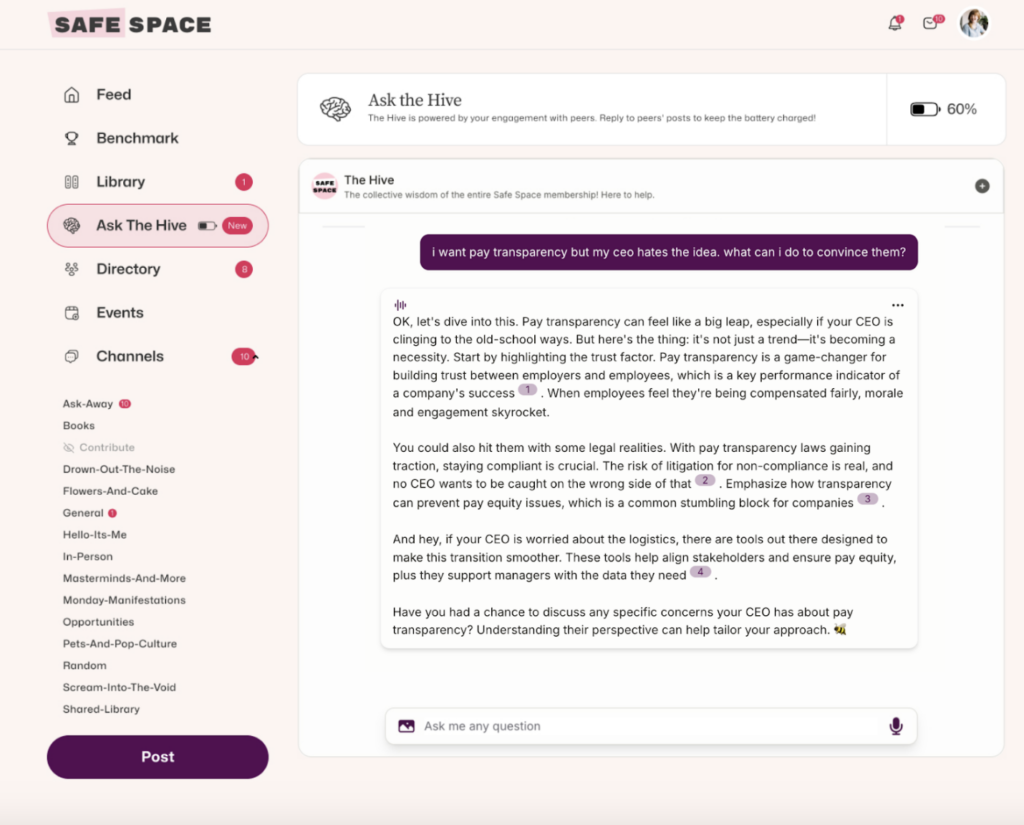This quarter, I’m asking you to rethink EVERYTHING you do in HR.
Why?
Well, because the end of the year is a great time for reflection. To look back and wonder “what could I have done differently?”
For me the answer is usually, a lot.
And it’s a great time to prepare for making moves in the next year.
Today I’ve tapped FOUR of the most talented talent folks I know to drop their wisdom on what to rethink when it comes to recruiting.
You’re going to hear about:
✅Employer brand
✅Interview process
✅Data
✅Quality of hire
But first before that, shoutout to my friends who took time out of their busy schedule to contribute to this newsletter AND hop on the pod this week:
JOIN 150K+ HR LEADERS
Get insights, learnings, and advice on how to build companies and cultures that people actually love.
No spam. Unsubscribe any time.
The convo was super fun and full of insights for recruiters AND job seekers. I even asked a few hot seat questions. You won’t want to miss this episode!
Okay, now onto what you should rethink when it comes to recruiting!
Your Employer Brand is Fooling No One
Let’s be real—recruiting content these days feels like bad sales copy, and candidates can tell.
Careers pages that could belong to any company. Job descriptions that sound like you’re hunting for a unicorn. Social posts that only show the wins but never the work. And don’t even get me started on recruitment emails that scream “spam.” 🙄
Here’s the problem: Every time your content feels overly polished or fake, you’re sending the message that your company isn’t authentic. And for qualified talent, that’s a massive red flag.
🔥Hot take: That overly curated careers page isn’t doing your employer brand any favors. If your content reads like it’s been through three rounds of legal review, candidates will assume your company has something to hide. The best talent? They want to see the real stuff—the messy, honest, behind-the-scenes reality.
Here’s how to fix it:
Start thinking about recruiting as matchmaking, not sales. Use your content to build trust by:
- Showing the real work environment, not just the ping pong tables
- Sharing actual employee stories (yes, even the tough ones)
- Being transparent about growth opportunities and challenges
- Getting real about who will and won’t thrive in the role
Authenticity doesn’t just help you attract talent—it helps you keep it. When you’re upfront about the realities of the role and your company culture, you attract people who are genuinely aligned with your values and thrive in your environment. And when you hire the right people, they stick around.
So stop selling the dream and start sharing the truth. Your retention rate will thank you.
Rhona Barnett-Pierce is the founder of Perceptible Studios, where she helps Talent Acquisition and HR leaders scale their impact through video and content creation. Building on her experience leading TA teams across Talent Marketplaces, SaaS, and Media, she brings deep expertise in employer branding, personal branding, and talent attraction. Rhona also hosts Throw Out the Playbook, a podcast reimagining recruiting for modern TA professionals. Connect with her on LinkedIn to learn how she’s helping leaders build trust through authentic, standout content.
Your Interview Process is Working Against You
Hiring the right person for the right role at the right time is one of the most critical—and often mishandled—challenges companies face. A lot of time, money, and energy are wasted on interview processes that don’t predict job performance or align with business needs.
Here are some common pitfalls I see in interviews:
👎 Too many stages, often added on a whim, which drag out timelines and frustrate candidates
👎 Unstructured questions that open the door for bias and fail to assess the skills necessary for the role
👎 Lack of clarity about what “success” looks like in the role, leaving interviewers unsure of what they’re evaluating
📣The good news?
There are better and proven ways to approach this predicament.
Structured interviewing provides a clear, thoughtful framework for identifying the best match for your team. It ensures that every question you ask, and every decision you make, aligns with the skills and qualities truly needed for the role. Candidates hired through structured processes are better equipped to succeed, leading to stronger retention. Even candidates who aren’t hired walk away with a more positive perception of your process because structured interviewing is strongly correlated with candidates’ sense of fairness.
Here’s what the data shows: candidates (whether hired or not) report higher satisfaction when the interview process stays under 60 days. By being intentional, avoiding unnecessary interviews, and implementing a fair process, you not only improve candidate NPS but also save your team and candidates valuable time.
Start with your hiring managers. Talk to them about the questions and topic areas they want to hear from all candidates. If implementing this across teams feels like a big lift, position it as a pilot project. The results will speak for themselves—and make scaling the process across your organization much easier.
For anyone wanting to dive deeper into this topic, I had a great conversation with Heather Doshay, Partner at SignalFire, on our Offer Accepted Podcast.
Shannon Ogborn has built her career in the talent space, with experience at StumbleUpon, Hired, and DEI-focused staffing at Google. Her passion for supporting talent teams and simplifying the hiring process inspired her to launch Offer Accepted, a podcast that brings practical insights and strategies from talent and hiring leaders across industries.
Shannon is a Community Lead at Ashby, an all-in-one recruiting platform that combines applicant tracking, scheduling, sourcing, and CRM tools with powerful analytics. She’s dedicated to fostering collaboration and sharing ideas that help talent teams overcome challenges and build stronger hiring practices.
Data Isn’t a Nasty Word
I’ll be honest – when I first started my Talent Acquisition (TA) career, I was nervous about how my performance was being measured against scary metrics like number of sourced candidates, time to hire, and time to fill. At the time, I was obsessed with the candidate experience but uninformed on how business outcomes tied to that experience.
Like many Recruiters, I was self taught and thrown into the fire. I was hungry to win though; this was my first time working at a startup, and the people who hired me believed in me.
After three months of trial and error with searches, I realized that my issue wasn’t with data – I didn’t know how to leverage it to my advantage! Many TA teams fail to gain favor with their stakeholders because we’ve built an adversary or uninformed relationship with data instead of a partnership.
When TA teams are frustrated with data, they:
❌ Find ways to leverage anecdotal examples from past searches to trump what’s currently happening in the pipeline
❌ Blame poor ATS tools for why they can’t share insights with stakeholders
❌ Manipulate data to sell a positive hiring story instead of sharing hard truths and missteps
These self preservation tactics make Recruiters feel good in the short-term but ultimately, harm the business in the long term in the most extreme cases.
Here’s how TA teams can build a partnership with their data:
✅ Reframe data as a learning tool and performance metric vs a performance metric only
✅ Choose one or two key metrics that align with your Hiring Manager’s goals. Share them out with the hiring team on an established cadence
✅ Have Recruiters shadow each other’s hiring kickoff calls so they can learn from each other’s data storytelling skills – practice, practice, practice as a team!
🔥Hot Take: Your goal as a Recruiter is to make your current recruiting strategy even better than the last one. There is no perfection in recruiting – there is only continuous learning and growth. Become an infectious learner, and trust me, people across the company will be begging to work with you again!
Sean Page is the TA Manager at Propel – an mobile app specifically designed for low income Americans to navigate social safety net programs. Sean has recruited for both technical and non-technical roles, built talent branding and operation programs from scratch, has developed robust talent sourcing strategies, and led hiring training programs with a DEI lens at scaling startups. Prior to Propel, Sean was the second TA hire for Webflow – a no-code website builder and hosting platform. Sean has worked across several industries including SaaS tech, fintech, non-profits, and the federal government. You can follow along on his journey via LinkedIn or X (formerly known as Twitter). 😉
Quality of Hire is Silly
Yup, I said it.
🔥And if you need it, I’ll happily affirm that you can be a recruiter who invests in post-hire outcomes, that rejects Quality of Hire.
Quality of Hire is often considered the Holy Grail of HR and recruiting. And because it has the word “hire” in it, it’s often tossed around the recruiting world. But like hiring, the process and outcome is a shared effort and result. We’ve all probably seen it weaponized against recruiters.
The only problem with QoH? It lacks a universal definition.
- Is is a metric like Net Promoter Score?
- Or is it an operations tool like scrum?
- Or is it neither of the two and far more esoteric. A philosophy like DevOps?
📣How we got here: A few years ago, quality of hire came roaring back into the world of recruiting. Companies were competing for talent more and more, particularly as startup investment was spiking. Employee tenure was shortening due to more employment options in the market. So quality of hire got a rebrand on the conference circuit and vendors and consultants started telling every recruiting and HR leader they could find about the importance of quality of hire.
In practice it can be deployed as a trailing indicator, there are a lot of formulas out there for calculating it, but at its core it’s flawed. A choose your own adventure at best.
Which in the world of work, just seems inefficient.
People Analytics as a rising field also played an impact on the credible case for QoH. There are some fantastic folks out there leading research projects on the motivations of employees. As a result, top companies are investing in data on their employees and processes. No shocker there.
The general idea is that if companies can identify the competencies of top performers that are well retained, then they can tie it to the recruitment process to find more people like them!
These competencies also don’t have an universal definition and the synonyms of attributes can become a bloated bank of ideological chaw. Even if we identify the competencies and attributes of top performers with strong post-hire outcomes, recruiting doesn’t operate in a vacuum.
The only problem is that the world of work can’t always, reliably, or 100% be quantified. Humans and the inputs on our life at work are far too nuanced, individualized, and adapting to be replicated with predictability at scale.
🗺️Where we’re going: If this is starting to sound like skills-based hiring, you’re right.
Much of the conversation around skills-based hiring and quality of hire stems from an outcomes written job description and structured interview plan. The foundations of great recruiting.
If you focus on the fundamentals now, you’ll be prepared to navigate a career in recruiting. There’s a lot of talk about recruiting being an art and science.
In the last few years we’ve seen an index on the science of hiring. As an early adopter of AI, I’m a believer in its capabilities for revolutionizing our workflows.
But I’m also a believer that the art of recruiting will win the day.
So my advice is to balance your recruiting media diet, if you’re only getting info about improving our recruiting workflows from vendors and consultants, then you’re being spoonfed what they want to sell you. Don’t be a sucker. Right now the most important thing you can focus on are the fundamentals of what makes you great at your job as a recruiter or people ops practitioner. So have philosophies for working, streamline your operations, and have actionable metrics that you can actually attain.
Brandon leads the People and Talent function at TLDR – a byte sized newsletter with more than 5 million software engineer subscribers. He’s worked with early stage tech startups including ethical AI HR tech, fintech, enterprise saas and more on their digital transformation, recruitment marketing, full-cycle recruitment and executive search. He’s an advisor to HR tech startups, industry speaker, and operates The Revol•TA Podcast for People & Talent leaders in the future of work. You can keep up with him on LinkedIn or give him a call. (Really).
What’s next:
It seems like every week I hear about another miscommunication at work.
Whether it’s through Slack/Teams, a poorly run meeting or an email gone awry communication hijinks are quite common.
So, what are we doing in 2025 to stop that from happening?
NEXT WEEK it’s all about rethinking your comms tools and how maybeee at the bottom of every conflict is a miscommunication.


